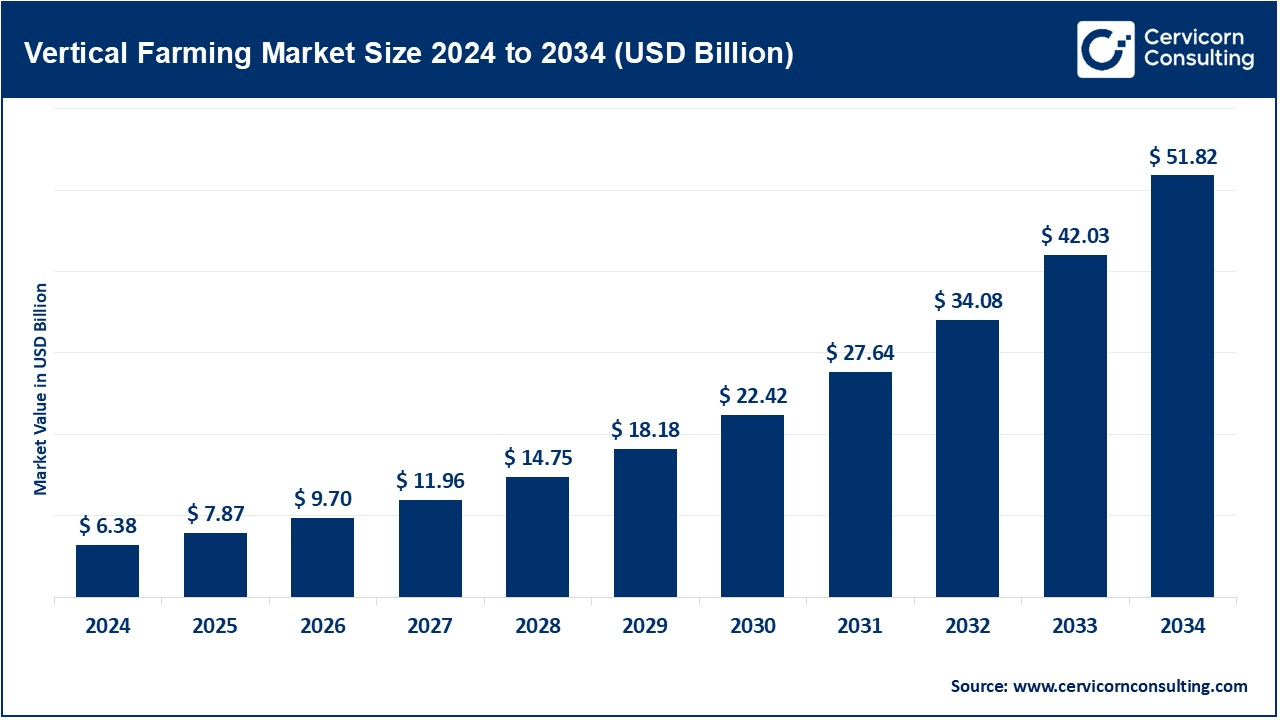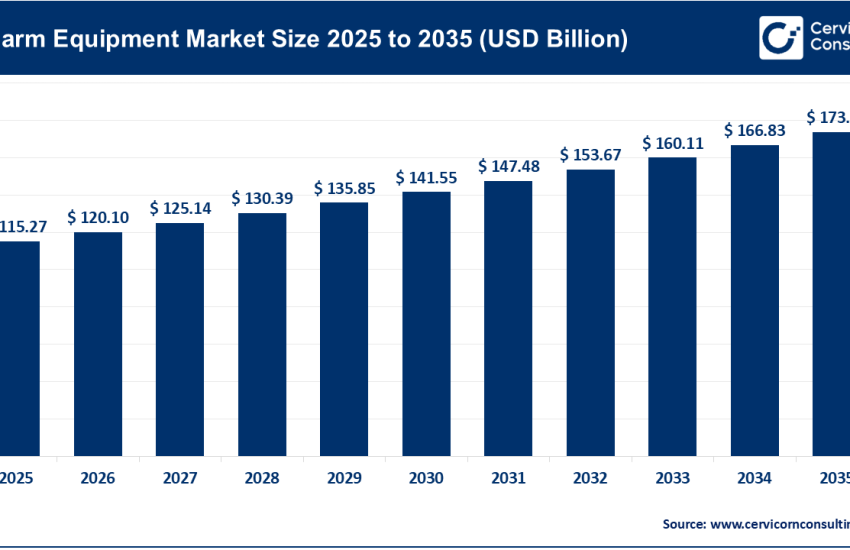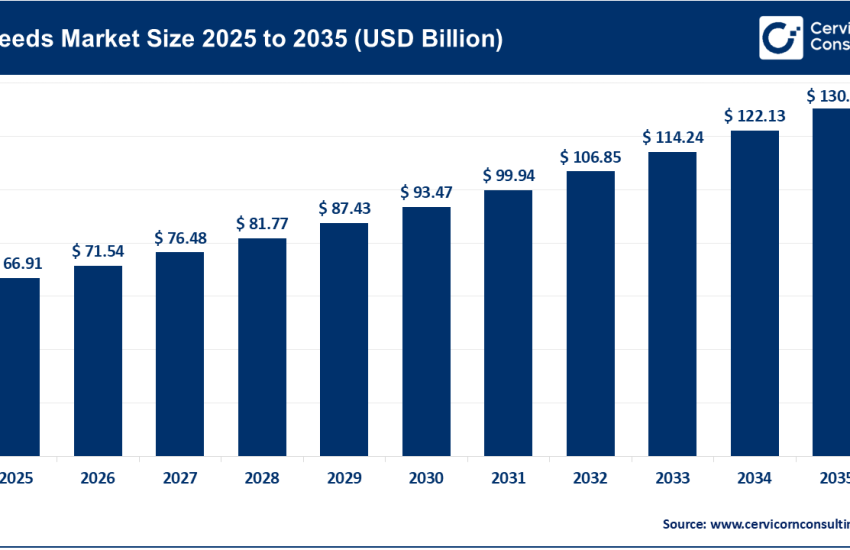Vertical Farming Market Size, Trends, Growth, and Key Players (2024-2034)
Vertical Farming Market Size
The global vertical farming market was worth USD 6.38 billion in 2024 and is anticipated to expand to around USD 51.82 billion by 2034, registering a compound annual growth rate (CAGR) of 23.30% from 2025 to 2034.
What is the Vertical Farming Market?
Vertical farming is a modern agricultural technique that involves growing crops in vertically stacked layers, often incorporating controlled-environment agriculture (CEA) technology. This method utilizes hydroponics, aeroponics, and aquaponics to optimize resource usage and maximize yield. Vertical farms are typically established in urban areas, warehouses, shipping containers, and even underground facilities, making them a viable solution for sustainable food production.
Why is Vertical Farming Important?
The growing global population, urbanization, and climate change challenges necessitate innovative agricultural solutions. Vertical farming offers a sustainable alternative to traditional farming by reducing land use, conserving water, eliminating the need for pesticides, and decreasing transportation costs and carbon footprints. Additionally, it enables year-round crop production, ensuring food security and stability.
Growth Factors of the Vertical Farming Market
The vertical farming market is experiencing rapid growth due to several key factors, including increasing demand for organic food, advancements in LED lighting technology, the rising adoption of hydroponic and aeroponic farming techniques, and supportive government policies promoting sustainable agricultural practices. Moreover, urbanization and the need for local food production are driving market expansion, with significant investments from agri-tech companies and venture capitalists fueling further development.
Get a Free Sample: https://www.cervicornconsulting.com/sample/2602
Vertical Farming Market Top Companies
1. ams-OSRAM AG
- Specialization: Advanced LED lighting solutions for controlled-environment agriculture.
- Key Focus Areas: High-efficiency lighting technology, smart horticultural lighting.
- Notable Features: Precision spectral tuning for optimal plant growth.
- 2024 Revenue (Approx.): $5.5 billion
- Market Share (Approx.): 10%
- Global Presence: Europe, North America, Asia-Pacific
2. Signify Holding
- Specialization: Smart lighting solutions for indoor farming.
- Key Focus Areas: LED grow lights, automation in farming.
- Notable Features: Sustainable agricultural lighting for higher yield and energy efficiency.
- 2024 Revenue (Approx.): $8 billion
- Market Share (Approx.): 12%
- Global Presence: North America, Europe, Asia-Pacific
3. Heliospectra
- Specialization: Intelligent LED grow lighting systems.
- Key Focus Areas: Light control systems, precision agriculture.
- Notable Features: AI-driven lighting for plant growth optimization.
- 2024 Revenue (Approx.): $400 million
- Market Share (Approx.): 5%
- Global Presence: Europe, North America
4. EVERLIGHT ELECTRONICS CO., LTD.
- Specialization: LED lighting and optoelectronics for indoor farming.
- Key Focus Areas: Customized LED solutions, spectral tuning for crops.
- Notable Features: Cost-effective and efficient lighting solutions.
- 2024 Revenue (Approx.): $1.2 billion
- Market Share (Approx.): 8%
- Global Presence: Asia-Pacific, North America, Europe
5. Urban Crop Solutions
- Specialization: Automated vertical farming solutions.
- Key Focus Areas: Indoor farming systems, crop optimization.
- Notable Features: Fully integrated plant factories for urban settings.
- 2024 Revenue (Approx.): $200 million
- Market Share (Approx.): 3%
- Global Presence: Europe, North America
Leading Trends and Their Impact on the Vertical Farming Market
- Advancements in LED Lighting Technology – The development of energy-efficient LED lights with customized spectrums enhances plant growth and reduces electricity consumption.
- Integration of AI and IoT – Smart farming technologies enable precision monitoring of crop health, nutrient levels, and environmental conditions.
- Expansion of Hydroponics and Aeroponics – Soil-less farming methods are gaining popularity due to their efficient resource usage and higher yield potential.
- Increased Automation – Robotic systems and machine learning algorithms are improving harvesting, planting, and monitoring efficiency.
- Growing Consumer Demand for Organic and Locally Sourced Food – Urban consumers are increasingly preferring pesticide-free, fresh produce.
Successful Examples of Vertical Farming Around the World
- AeroFarms (USA): One of the world’s largest vertical farms, specializing in aeroponic farming techniques, producing leafy greens with minimal resource usage.
- Sky Greens (Singapore): A pioneer in hydraulic-driven vertical farms, maximizing urban space efficiency.
- Plenty (USA): Backed by major investors, utilizing AI-driven indoor farming to scale sustainable food production.
- Infarm (Germany): A network of in-store farming units providing fresh produce directly to supermarkets.
- Oishii (USA): Specializes in vertical strawberry farming, producing premium-quality fruit year-round.
Regional Analysis and Government Initiatives
North America
- Government Support: The USDA provides grants for urban farming projects.
- Key Markets: The U.S. and Canada have growing investments in controlled-environment agriculture.
- Major Trends: High adoption of automation and AI-driven farming systems.
Europe
- Government Support: The European Commission funds sustainable agriculture projects through the Green Deal.
- Key Markets: Germany, the Netherlands, and the UK lead in vertical farming adoption.
- Major Trends: Emphasis on reducing food miles and sustainable urban farming.
Asia-Pacific
- Government Support: Japan, Singapore, and China offer subsidies for smart farming technologies.
- Key Markets: China and Japan are major players in automated farming solutions.
- Major Trends: Growing investments in large-scale vertical farms.
Middle East & Africa
- Government Support: UAE and Saudi Arabia focus on food security through agri-tech investments.
- Key Markets: Dubai and Riyadh are emerging hubs for vertical farming.
- Major Trends: High adoption of hydroponics to combat water scarcity.
To Get Detailed Overview, Contact Us: https://www.cervicornconsulting.com/contact-us
Read Report: Agrivoltaics Market Size to Reach USD 12.26 Billion by 2034



